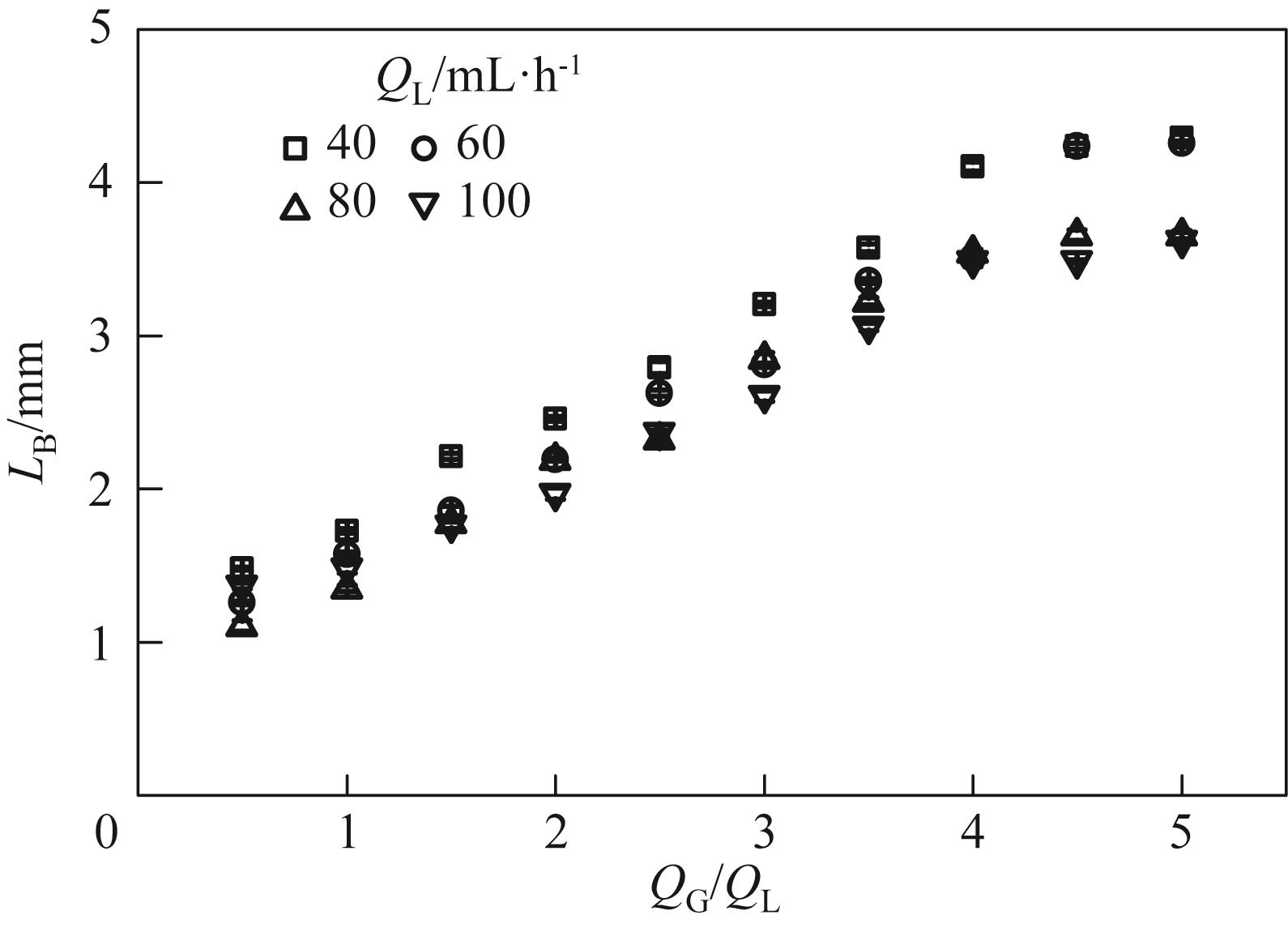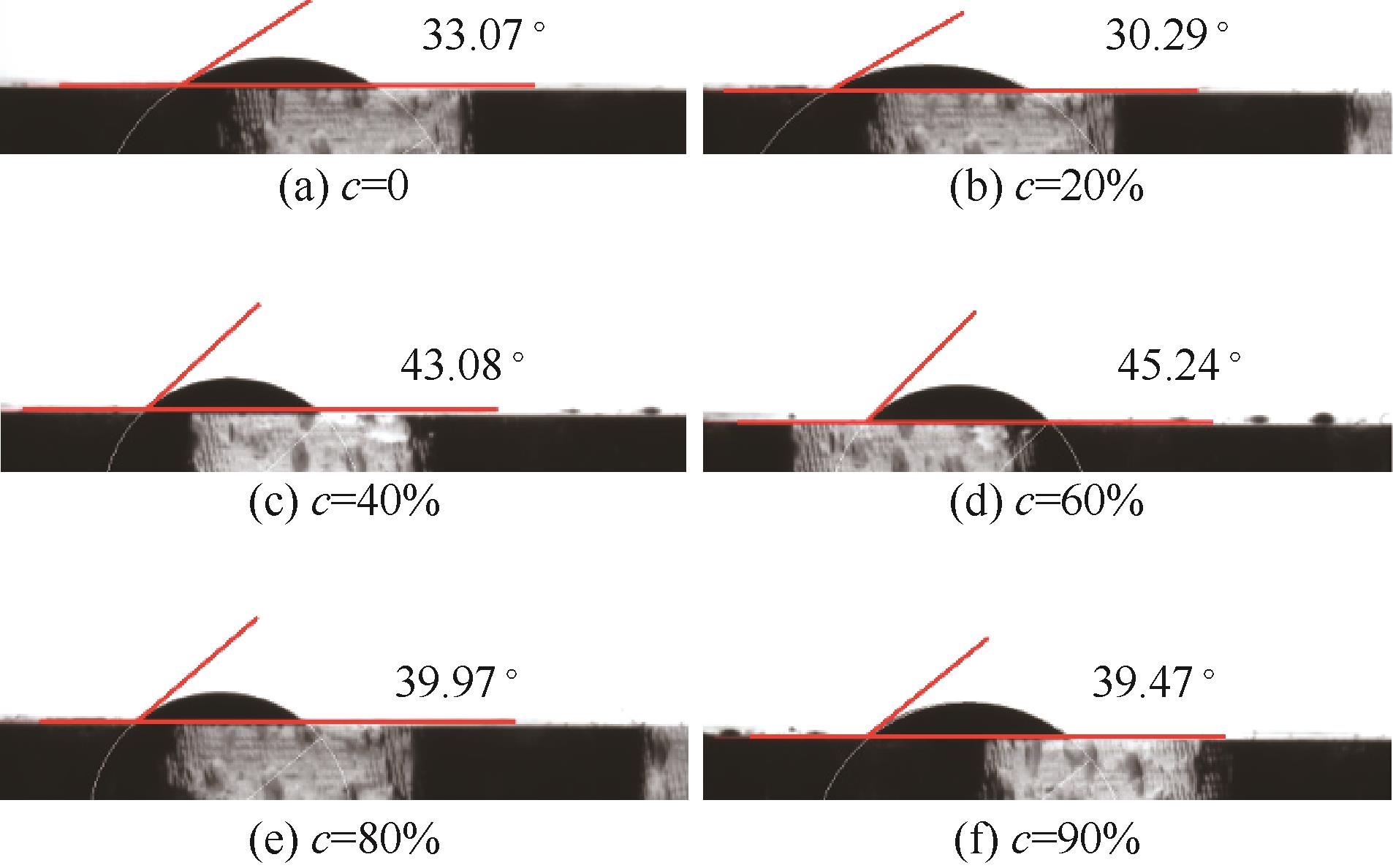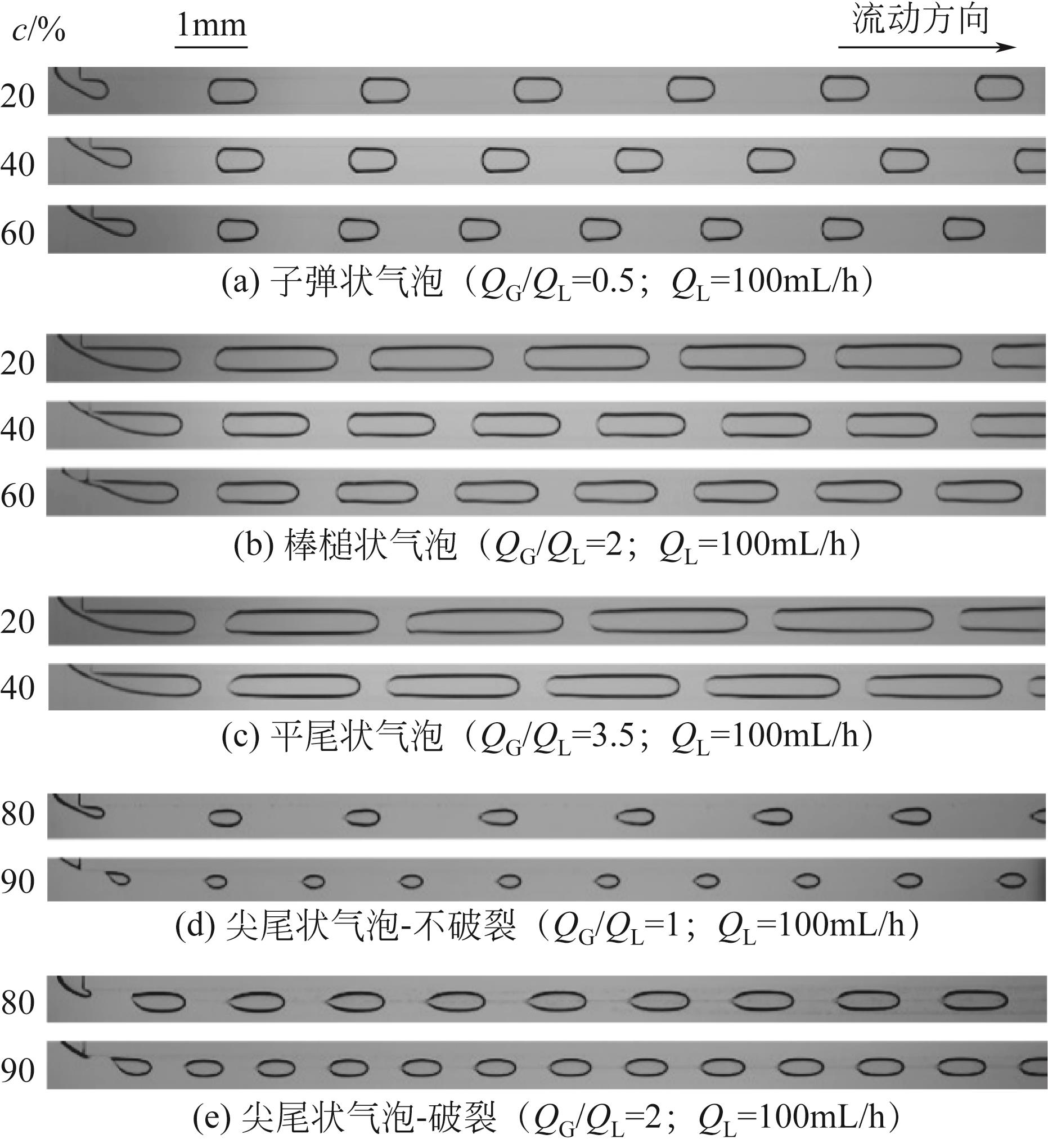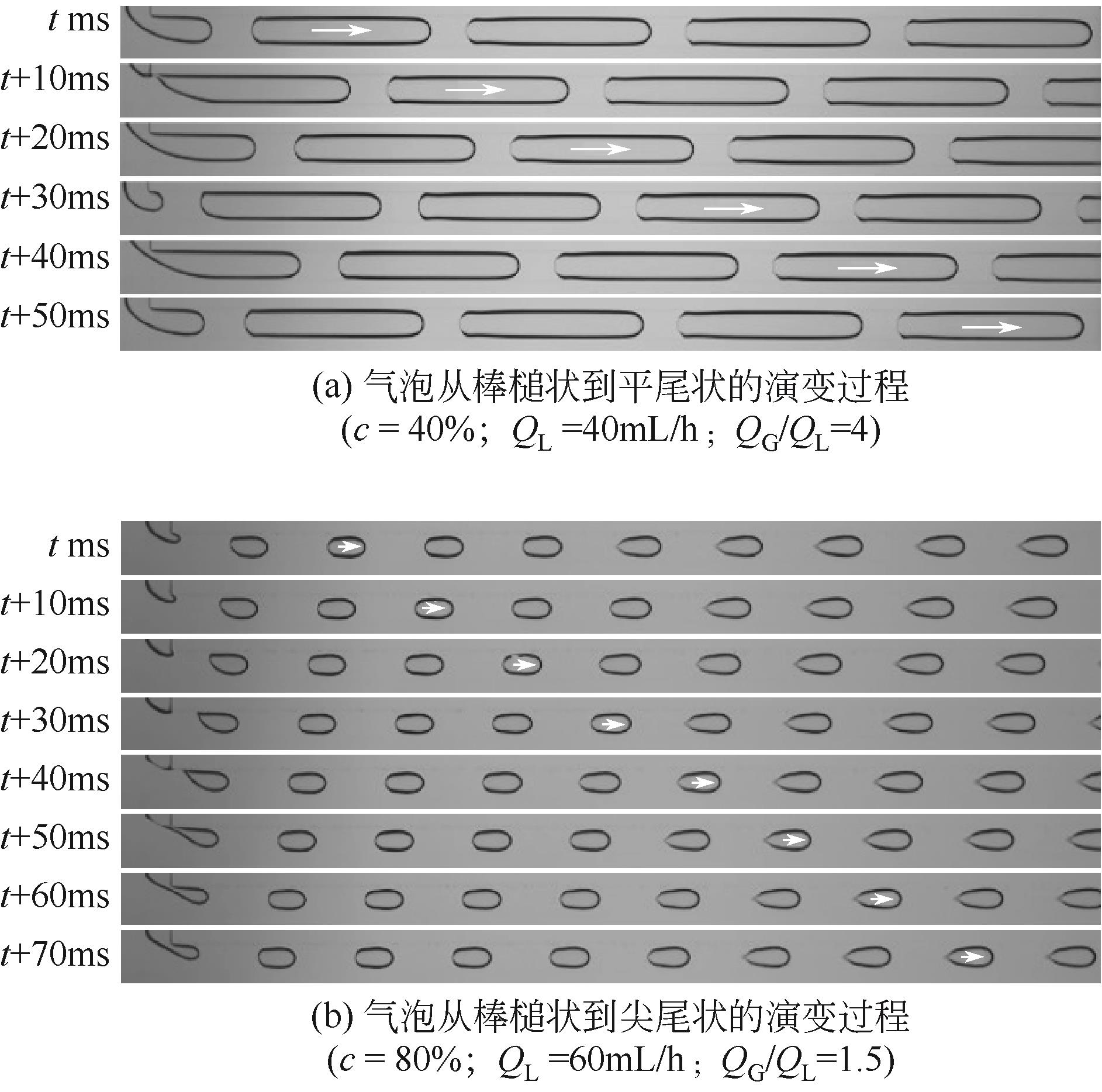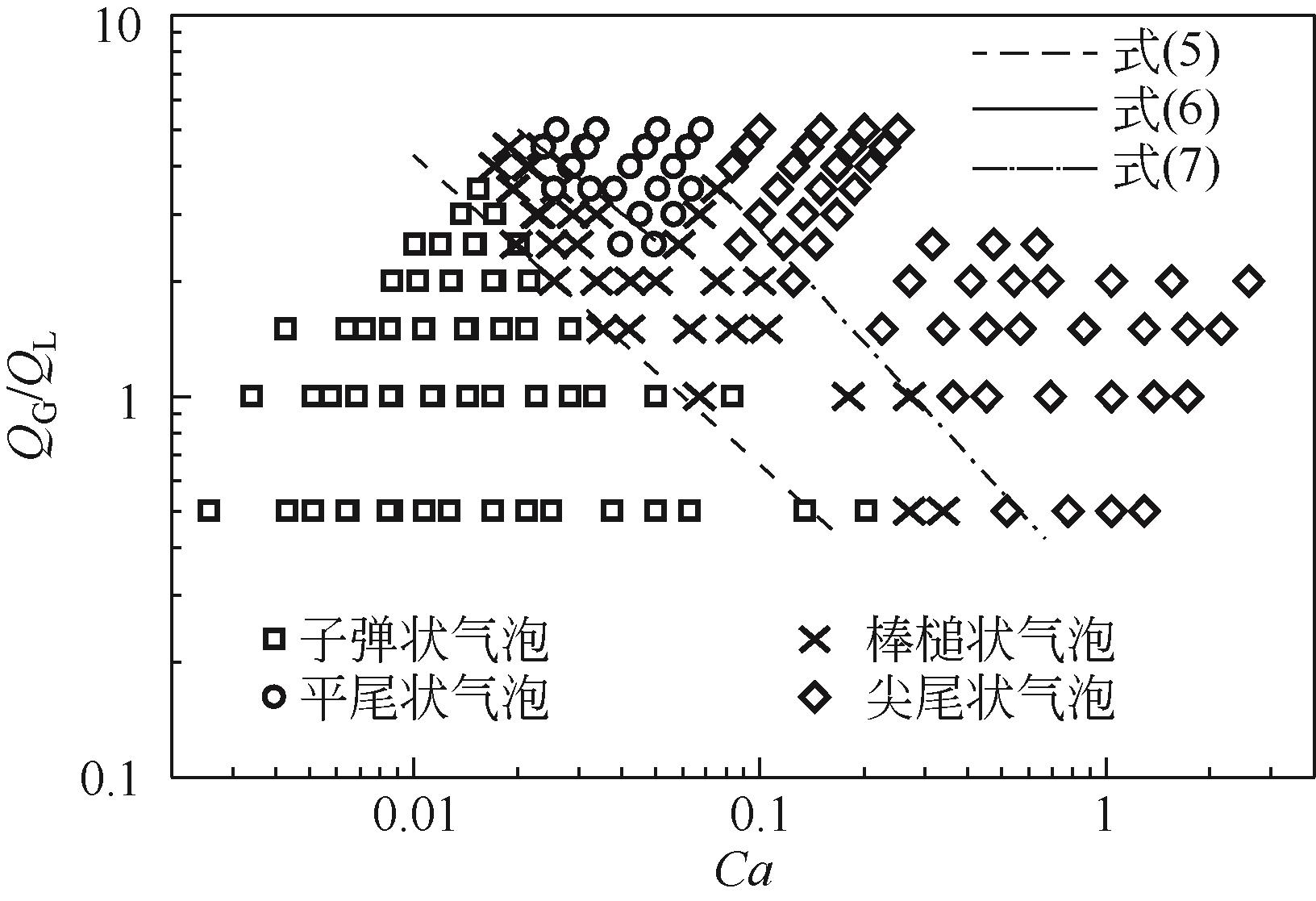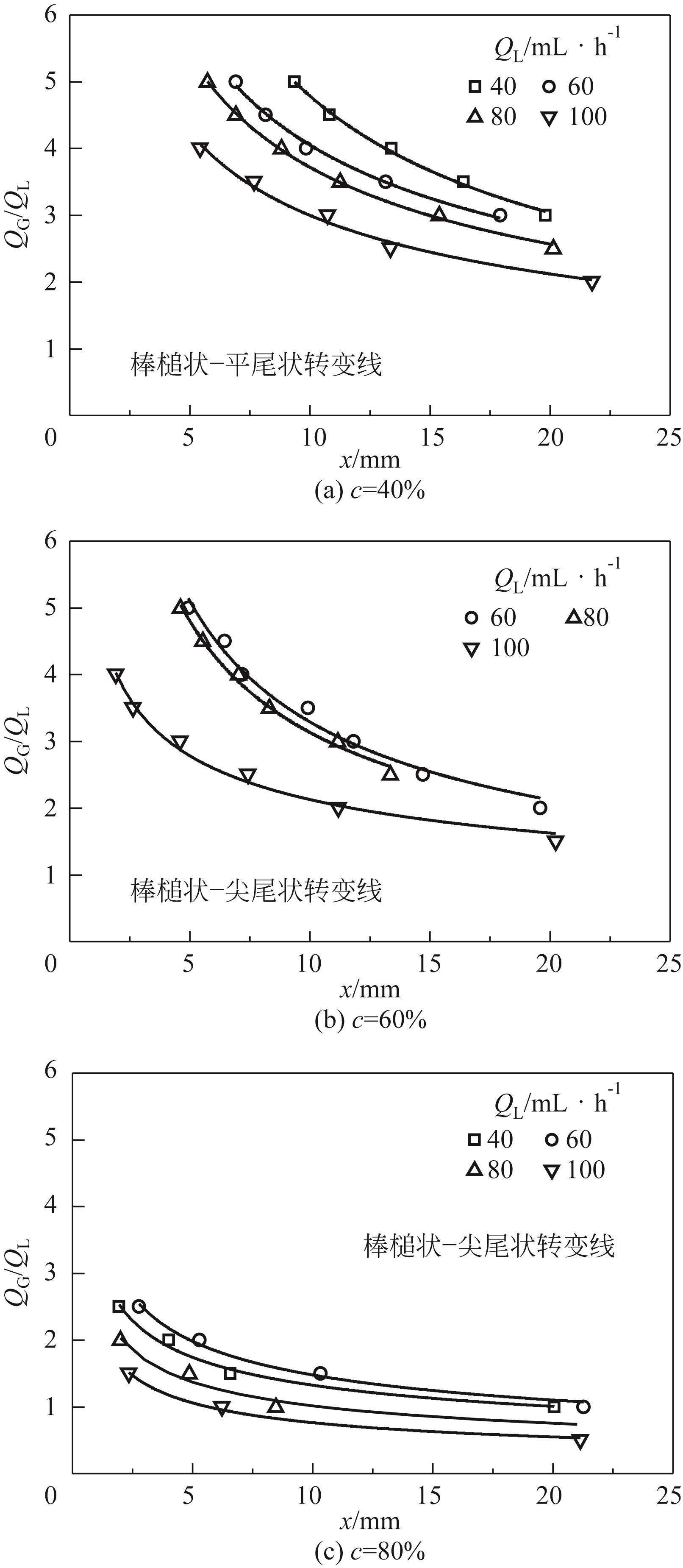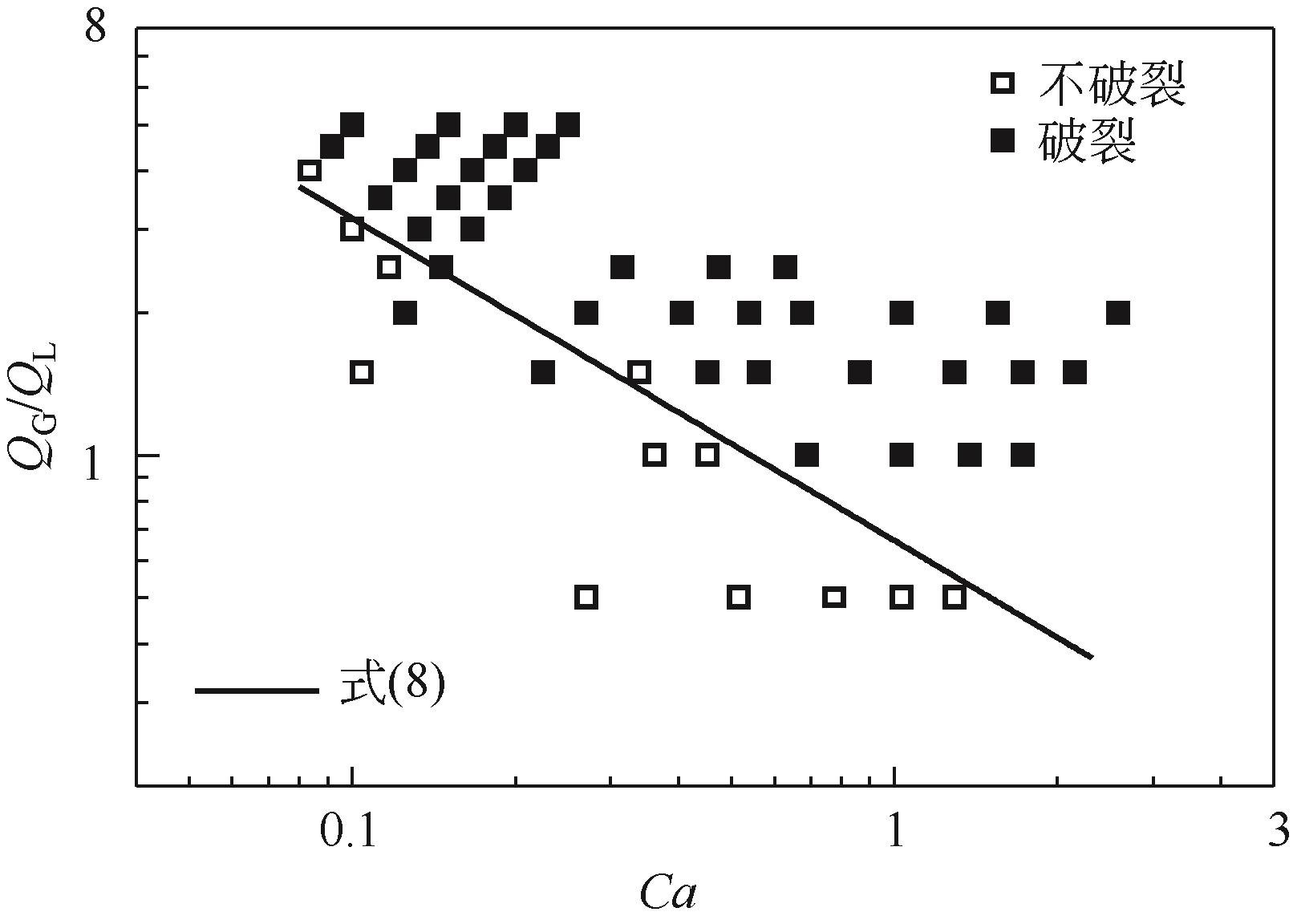化工进展 ›› 2023, Vol. 42 ›› Issue (7): 3468-3477.DOI: 10.16085/j.issn.1000-6613.2022-1721
矩形微通道内液相黏度对气泡界面的作用机制
陈蔚阳1( ), 宋欣1, 殷亚然1(
), 宋欣1, 殷亚然1( ), 张先明1(
), 张先明1( ), 朱春英2, 付涛涛2, 马友光2
), 朱春英2, 付涛涛2, 马友光2
- 1.浙江理工大学材料科学与工程学院,纺织纤维材料与加工技术国家地方联合工程研究中心,浙江 杭州 310018
2.化学工程联合国家重点实验室,天津大学化工学院,天津 300072
-
收稿日期:2022-09-15修回日期:2022-11-19出版日期:2023-07-15发布日期:2023-08-14 -
通讯作者:殷亚然,张先明 -
作者简介:陈蔚阳(1998—),女,硕士研究生,研究方向为微反应器内过程强化。E-mail:cwy9896@163.com。 -
基金资助:浙江省自然科学基金(LQ21B060009);国家自然科学基金(22008220);浙江省重点研发计划(2020C01143);浙江理工大学科研启动基金(19012403-Y)
Effect of liquid viscosity on bubble interface in the rectangular microchannel
CHEN Weiyang1( ), SONG Xin1, YIN Yaran1(
), SONG Xin1, YIN Yaran1( ), ZHANG Xianming1(
), ZHANG Xianming1( ), ZHU Chunying2, FU Taotao2, MA Youguang2
), ZHU Chunying2, FU Taotao2, MA Youguang2
- 1.School of Materials Science and Engineering, Zhejiang Sci-Tech University, National & Local Joint Engineering Research Center for Textile Fiber Materials and Processing Technology, Hangzhou 310018, Zhejiang, China
2.State Key Laboratory of Chemical Engineering, School of Chemical Engineering and Technology, Tianjin University, Tianjin 300072, China
-
Received:2022-09-15Revised:2022-11-19Online:2023-07-15Published:2023-08-14 -
Contact:YIN Yaran, ZHANG Xianming
摘要:
利用高速摄像机对矩形微通道中不同黏度体系下气泡的形状及界面演变进行实验研究。实验观察到子弹状、棒槌状、平尾状和尖尾状四种气泡形状,其中液弹的挤压力控制气泡尾部由凸形变平形或凹形,而受限空间效应和液相黏性剪切导致气泡形状为贴近壁面的尖尾状。基于两相Ca数和气液流率比绘制了气泡形状分布图并建立形状转变模型。平尾状和尖尾状气泡均是由棒槌状气泡演变而来,转变距离分别随气泡上游液弹压力和液相黏性剪切力的增加而减小,并且均与气/液流率比呈幂律关系,幂律指数小于零。尖尾状气泡破裂发生在尖端且存在临界条件,根据Ca数和气液流率比提出了破裂条件的良好预测模型。本工作对于矩形微通道内气泡的流动与破裂调控具有重要的指导意义。
中图分类号:
引用本文
陈蔚阳, 宋欣, 殷亚然, 张先明, 朱春英, 付涛涛, 马友光. 矩形微通道内液相黏度对气泡界面的作用机制[J]. 化工进展, 2023, 42(7): 3468-3477.
CHEN Weiyang, SONG Xin, YIN Yaran, ZHANG Xianming, ZHU Chunying, FU Taotao, MA Youguang. Effect of liquid viscosity on bubble interface in the rectangular microchannel[J]. Chemical Industry and Engineering Progress, 2023, 42(7): 3468-3477.
| c/% | ρL/kg·m–3 | μL/mPa·s | σ/mN·m–1 |
|---|---|---|---|
| 0 | 998.2 | 1.23 | 33.63 |
| 20 | 1047.1 | 2.09 | 33.56 |
| 40 | 1099.1 | 4.00 | 32.75 |
| 60 | 1153.6 | 12.10 | 32.53 |
| 80 | 1208.2 | 62.60 | 32.10 |
| 90 | 1235.4 | 236.00 | 31.66 |
表1 甘油水溶液的物理性质
| c/% | ρL/kg·m–3 | μL/mPa·s | σ/mN·m–1 |
|---|---|---|---|
| 0 | 998.2 | 1.23 | 33.63 |
| 20 | 1047.1 | 2.09 | 33.56 |
| 40 | 1099.1 | 4.00 | 32.75 |
| 60 | 1153.6 | 12.10 | 32.53 |
| 80 | 1208.2 | 62.60 | 32.10 |
| 90 | 1235.4 | 236.00 | 31.66 |
| 1 | TEWS I J, TERRELL E, MOOD S H, et al. Wet oxidation of thermochemical aqueous effluent utilizing char catalysts in microreactors[J]. Journal of Cleaner Production, 2022, 351: 131222. |
| 2 | GUO Shuai, ZHU Guangkai, ZHAN Lewu, et al. Continuous kilogram-scale process for the synthesis strategy of 1,3,5-trimethyl-2-nitrobenzene in microreactor[J]. Chemical Engineering Research and Design, 2022, 178: 179-188. |
| 3 | MUSCI Pantaleo, COLELLA Marco, SIVO Alessandra, et al. Flow microreactor technology for taming highly reactive chloroiodomethyllithium carbenoid: Direct and chemoselective synthesis of α-chloroaldehydes[J]. Organic Letters, 2020, 22(9): 3623-3627. |
| 4 | 侯跃辉, 刘璇, 廉应江, 等. 超声微反应器内三硝基间苯三酚合成工艺研究[J]. 化工学报, 2022, 73(8): 3597-3607. |
| HOU Yuehui, LIU Xuan, LIAN Yingjiang, et al. Synthesis process of trinitrophloroglucinol in an ultrasonic microreactor[J]. CIESC Journal, 2022, 73(8): 3597-3607. | |
| 5 | JI Desheng, JIN Nan, YUE Jun, et al. Hydrodynamics and mass transfer characteristics for extractive desulfurization of diesel using highly viscous ionic liquids in microchannels: The effect of the phase ratio and temperature[J]. Industrial & Engineering Chemistry Research, 2022, 61(15): 5351-5362. |
| 6 | XU J H, LI S W, TAN J, et al. Correlations of droplet formation in T-junction microfluidic devices: From squeezing to dripping[J]. Microfluidics and Nanofluidics, 2008, 5(6): 711-717. |
| 7 | FOROUGHI Hooman, KAWAJI Masahiro. Viscous oil-water flows in a microchannel initially saturated with oil: Flow patterns and pressure drop characteristics[J]. International Journal of Multiphase Flow, 2011, 37(9): 1147-1155. |
| 8 | YAGODNITSYNA A A, KOVALEV A V, BILSKY A V. Flow patterns of immiscible liquid-liquid flow in a rectangular microchannel with T-junction[J]. Chemical Engineering Journal, 2016, 303: 547-554. |
| 9 | 陈一宇, 朱春英, 付涛涛, 等. 三维菱形结构微通道内气液传质与强化[J]. 化工学报, 2022, 73(1): 175-183. |
| CHEN Yiyu, ZHU Chunying, FU Taotao, et al. Gas-liquid mass transfer and intensification in 3D-rhombus microchannel[J]. CIESC Journal, 2022, 73(1): 175-183. | |
| 10 | WANG Xiaoda, LIU Yuanyuan, LIU Dayu, et al. Droplet breakup in the square microchannel with a short square constriction to generate slug flow[J]. AIChE Journal, 2022, 68(8): e17739. |
| 11 | KINOSHITA Haruyuki, KANEDA Shohei, FUJII Teruo, et al. Three-dimensional measurement and visualization of internal flow of a moving droplet using confocal micro-PIV[J]. Lab on a Chip, 2007, 7(3): 338-346. |
| 12 | SARRAZIN Flavie, Karine LOUBIÈRE, PRAT Laurent, et al. Experimental and numerical study of droplets hydrodynamics in microchannels[J]. AIChE Journal, 2006, 52(12): 4061-4070. |
| 13 | 李京坤, 陈斌, 吴彬彬, 等. 对称Y型微通道内气泡流动研究[J]. 工程热物理学报, 2022, 43(5): 1329-1336. |
| LI Jingkun, CHEN Bin, WU Binbin, et al. Bubbly flows in symmetrical Y-junction microchannels[J]. Journal of Engineering Thermophysics, 2022, 43(5): 1329-1336. | |
| 14 | MARTINEZ M J, UDELL K S. Axisymmetric creeping motion of drops through circular tubes[J]. Journal of Fluid Mechanics, 1990, 210: 565-591. |
| 15 | KOVALEV A V, YAGODNITSYNA A A, BILSKY A V. Flow hydrodynamics of immiscible liquids with low viscosity ratio in a rectangular microchannel with T-junction[J]. Chemical Engineering Journal, 2018, 352: 120-132. |
| 16 | CHANG Jian, CAI Jiejin. Numerical research on bubble formation process in microchannel using diffuse Interface method[J]. Heat and Mass Transfer, 2019, 55(11): 3133-3149. |
| 17 | YAO Chaoqun, ZHENG Jia, ZHAO Yuchao, et al. Characteristics of gas-liquid Taylor flow with different liquid viscosities in a rectangular microchannel[J]. Chemical Engineering Journal, 2019, 373: 437-445. |
| 18 | ZHAO Yuchao, CHEN Guangwen, YE Chunbo, et al. Gas-liquid two-phase flow in microchannel at elevated pressure[J]. Chemical Engineering Science, 2013, 87: 122-132. |
| 19 | FEI Yingjie, ZHU Chunying, FU Taotao, et al. Slug bubble deformation and its influence on bubble breakup dynamics in microchannel[J]. Chinese Journal of Chemical Engineering, 2022 |
| 20 | WU Yining, FU Taotao, ZHU Chunying, et al. Shear-induced tail breakup of droplets (bubbles) flowing in a straight microfluidic channel[J]. Chemical Engineering Science, 2015, 135: 61-66. |
| 21 | SAUZADE M, CUBAUD T. Initial microfluidic dissolution regime of CO2 bubbles in viscous oils[J]. Physical Review E, Statistical, Nonlinear, and Soft Matter Physics, 2013, 88(5): 051001. |
| 22 | TANG G H, LI Z, HE Y L, et al. Experimental study of compressibility, roughness and rarefaction influences on microchannel flow[J]. International Journal of Heat and Mass Transfer, 2007, 50(11/12): 2282-2295. |
| 23 | WANG Xin, LIU Zhanqiang, YANG Yuwei, et al. Effects of sidewall roughness on mixing performance of zigzag microchannels[J]. Chemical Engineering and Processing - Process Intensification, 2022, 179: 109057. |
| 24 | GUPTA R, LEUNG S S, MANICA R, et al. Hydrodynamics of liquid-liquid Taylor flow in microchannels[J]. Chemical Engineering Science, 2013, 92: 180-189. |
| 25 | CAI Q W, JU X J, CHEN C, et al. Fabrication and flow characteristics of monodisperse bullet-shaped microparticles with controllable structures[J]. Chemical Engineering Journal, 2019, 370: 925-937. |
| 26 | ABIEV R S. Analysis of local pressure gradient inversion and form of bubbles in Taylor flow in microchannels[J]. Chemical Engineering Science, 2017, 174: 403-412. |
| 27 | WANG Changliang, TIAN Maocheng, ZHANG Jingzhi, et al. Experimental study on liquid-liquid two-phase flow patterns and plug hydrodynamics in a small channel[J]. Experimental Thermal and Fluid Science, 2021, 129: 110455. |
| 28 | ATASI O, HAUT B, PEDRONO A, et al. Influence of soluble surfactants and deformation on the dynamics of centered bubbles in cylindrical microchannels[J]. Langmuir: The ACS Journal of Surfaces and Colloids, 2018, 34(34): 10048-10062. |
| 29 | WANG Guanqiu, ZHU Chunying, FU Taotao, et al. Formation mechanism and criterion of tail satellite droplets for moving droplet in microchannel[J]. Chemical Engineering Science, 2021, 238: 116607. |
| 30 | ABIEV R S. Taylor vortex center, film thickness, velocity and frequency of circulations in slugs and plugs for non-Newtonian and Newtonian fluids in two-phase Taylor flow in microchannels[J]. Chemical Engineering Science, 2022, 250: 117380. |
| 31 | 刘浪宇, 朱春英, 马友光, 等. 微通道内表面活性剂与界面传递现象研究进展[J]. 化工学报, 2021, 72(2): 783-798. |
| LIU Langyu, ZHU Chunying, MA Youguang, et al. Progress on surfactant and interfacial transport phenomena in microchannels[J]. CIESC Journal, 2021, 72(2): 783-798. | |
| 32 | EGGLETON C D, TSAI T M, STEBE K J. Tip streaming from a drop in the presence of surfactants[J]. Physical Review Letters, 2001, 87(4): 048302. |
| 33 | PETERS I, SNOEIJER J H, DAERR A, et al. Coexistence of two singularities in dewetting flows: Regularizing the corner tip[J]. Physical Review Letters, 2009, 103(11): 114501. |
| 34 | KALLI Maria, ANGELI Panagiota. Effect of surfactants on drop formation flow patterns in a flow-focusing microchannel[J]. Chemical Engineering Science, 2022, 253: 117517. |
| 35 | FUERSTMAN M J, LAI A, THURLOW M E, et al. The pressure drop along rectangular microchannels containing bubbles[J]. Lab on a Chip, 2007, 7(11): 1479-1489. |
| 36 | MANDAL Shubhadeep, Sayan DAS, CHAKRABORTY Suman. Effect of Marangoni stress on the bulk rheology of a dilute emulsion of surfactant-laden deformable droplets in linear flows[J]. Physical Review Fluids, 2017, 2(11): 113604. |
| 37 | YAO Chaoqun, ZHAO Yuchao, ZHENG Jia, et al. The effect of liquid viscosity and modeling of mass transfer in gas-liquid slug flow in a rectangular microchannel[J]. AIChE Journal, 2020, 66(5): e16934. |
| 38 | ZHANG Taoxian, SHAO Ting, ZHANG Yingjuan, et al. Effect of interface deformation on hydrodynamics of liquid-liquid two-phase flow in a confined microchannel[J]. Chemical Engineering Journal, 2022, 427: 131956. |
| 39 | YAO Chaoqun, DONG Zhengya, ZHANG Yuchao, et al. On the leakage flow around gas bubbles in slug flow in a microchannel[J]. AIChE Journal, 2015, 61(11): 3964-3972. |
| 40 | CHEN Zhen, ZHU Chunying, FU Taotao, et al. Formation dynamics and size prediction of bubbles for slurry system in T-shape microchannel[J]. Chinese Journal of Chemical Engineering, 2022, 45: 153-161. |
| 41 | 张政, 常骞, 陈国平. Y型微通道内气泡生成过程及行为研究[J]. 化学工程, 2021, 49(9): 46-51. |
| ZHANG Zheng, CHANG Qian, CHEN Guoping. Bubble formation process and behavior in Y-type microchannels[J]. Chemical Engineering (China), 2021, 49(9): 46-51. |
| [1] | 王太, 苏硕, 李晟瑞, 马小龙, 刘春涛. 交流电场中贴壁气泡的动力学行为[J]. 化工进展, 2023, 42(S1): 133-141. |
| [2] | 盛维武, 程永攀, 陈强, 李小婷, 魏嘉, 李琳鸽, 陈险峰. 微气泡和微液滴双强化脱硫反应器操作分析[J]. 化工进展, 2023, 42(S1): 142-147. |
| [3] | 赵晨, 苗天泽, 张朝阳, 洪芳军, 汪大海. 负压状态窄缝通道乙二醇水溶液传热特性[J]. 化工进展, 2023, 42(S1): 148-157. |
| [4] | 戚志程, 马润梅, 李双喜, 刘丽静, 闫欣欣. 高压法兰内开孔金属O形环密封性能及变形失效分析[J]. 化工进展, 2023, 42(S1): 166-174. |
| [5] | 杨寒月, 孔令真, 陈家庆, 孙欢, 宋家恺, 王思诚, 孔标. 微气泡型下向流管式气液接触器脱碳性能[J]. 化工进展, 2023, 42(S1): 197-204. |
| [6] | 奚永兰, 王成成, 叶小梅, 刘洋, 贾昭炎, 曹春晖, 韩挺, 张应鹏, 田雨. 微纳米气泡在厌氧消化中的应用研究进展[J]. 化工进展, 2023, 42(8): 4414-4423. |
| [7] | 俞俊楠, 俞建峰, 程洋, 齐一搏, 化春键, 蒋毅. 基于深度学习的变宽度浓度梯度芯片性能预测[J]. 化工进展, 2023, 42(7): 3383-3393. |
| [8] | 谢志伟, 吴张永, 朱启晨, 蒋佳骏, 梁天祥, 刘振阳. 植物油基Ni0.5Zn0.5Fe2O4磁流体的黏度特性及磁黏特性[J]. 化工进展, 2023, 42(7): 3623-3633. |
| [9] | 孙征楠, 李洪晶, 荆国林, 张福宁, 颜飚, 刘晓燕. EVA及其改性聚合物在原油降凝剂领域的应用[J]. 化工进展, 2023, 42(6): 2987-2998. |
| [10] | 章凯, 金捍宇, 刘思宇, 王帅. 鼓泡流态化气泡间相互作用下相间传质过程的模拟[J]. 化工进展, 2023, 42(6): 2828-2835. |
| [11] | 陶梦琦, 刘美红, 康宇驰. 基于micro-PIV的微通道内流体绕流单微圆柱和并联双微圆柱流场特性[J]. 化工进展, 2023, 42(6): 2836-2844. |
| [12] | 田启凯, 郑海萍, 张少斌, 张静, 余子夷. 混合增强的微流控通道进展[J]. 化工进展, 2023, 42(4): 1677-1687. |
| [13] | 李光文, 华渠成, 黄作鑫, 达志坚. 聚甲基丙烯酸酯类黏度指数改进剂的研究进展[J]. 化工进展, 2023, 42(3): 1562-1571. |
| [14] | 罗小平, 樊鹏, 周建阳, 王梦圆. 不同波纹壁面微细通道沸腾曲线及沸腾起始点研究[J]. 化工进展, 2023, 42(3): 1228-1239. |
| [15] | 黄起中, 刘冰, 马红鹏, 吕文杰. 基于新型微通道分离技术的甲醇制烯烃废水处理[J]. 化工进展, 2023, 42(2): 669-676. |
| 阅读次数 | ||||||
|
全文 |
|
|||||
|
摘要 |
|
|||||

